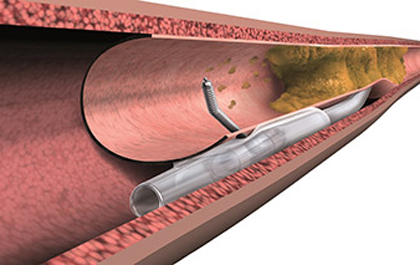
The EXPLORE (Evaluating Xience and Left Ventricular Function in Percutaneous Coronary Intervention on Occlusions After ST-Elevation Myocardial Infarction) trial evaluated whether patients admitted with acute myocardial infarction and concurrent chronic total occlusion benefit from rechanneling such a vessel shortly after primary angioplasty.
From November 2007 to April 2015, the trial enrolled 304 patients with acute ST-segment elevation myocardial infarction who underwent primary angioplasty in the infarct-related artery in 14 centers in Europe and Canada and had concurrent chronic total occlusion.
A total of 150 patients were randomly assigned to undergo an attempt at rechanneling the occlusion shortly after primary angioplasty, and the remaining 154 patients were assigned to conservative treatment without attempting rechanneling.
The primary endpoints were left ventricular function and end diastolic volume on magnetic resonance imaging at four months.
Success rate for the rechanneling attempt was 77%.
At four months, the left ventricular function was similar for both groups:
Rechanneling treatment group: 44.1 ± 12.2%
Conservative treatment group: 44.8 ± 11.9%
(p = 0.60)
Something similar happened with the end diastolic volume:
Rechanneling treatment group: 215.6 ± 62.5 ml
Conservative treatment group: 212.8 ± 60.3 ml
(p = 0.70)
Subgroup analysis showed that patients with total occlusions located in the anterior descending artery benefited from improved ventricular function after rechanneling, when compared with patients who received conservative treatment.
Patients with total occlusions in the anterior descending artery: 47.2 ± 12.3%
Patients who received conservative treatment: 40.4 ± 11.9%
(p = 0.02)
There were no differences as regards adverse coronary events at four months (5.4% vs. 2.6%; p = 0.25).
Conclusion
Rechanneling of a chronic total occlusion in a non-infarct-related vessel within a week after primary angioplasty was feasible and safe. However, it offered no benefit in terms of improved ventricular function or end diastolic volume when compared to primary angioplasty associated with conservative treatment for total occlusion.
The subgroup analysis must be confirmed through further investigation.
Original title: Percutaneous Intervention for Concurrent Chronic Total Occlusions in Patients with STEMI. The EXPLORE Trial.
Reference: José P.S. Henriques et al. J Am Coll Cardiol. 2016;68(15):1622-1632.
Subscribe to our weekly newsletter
Get the latest scientific articles on interventional cardiology
We value your opinion. You are more than welcome to leave your comments, suggestions or questions here below.





